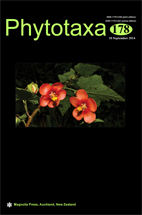Abstract
Pilostyles boyacensis, a new Apodanthaceae from Colombia, is described and illustrated. The species was found between 2000 and 2415 m elevation, parasitizing Dalea cuatrecasasii (Fabaceae:Papilionoideae) in dry interandean valleys of the Colombian Eastern Cordillera. The species can be distinguished from its congeners by the monoecious condition, the small size (1.5–2.5 mm in diameter) of the almost cleistogamous and tubular flowers, and the presence of five or six white petals and three to four rows of pollen sacs. The locations of the new species are among the highest for the genus in the Americas, and are altitudinally isolated from the tetrapetalous P. thurberi, from S United States and Mexico, P. mexicana from Mexico, Honduras and Guatemala, P. blanchetii from Jamaica, Cayman Islands, Costa Rica, Panama, Venezuela, Brazil and N Argentina, and P. berteroi from Peru, Bolivia, Chile and Argentina, none of which (except P. thurberi) parasitizes Dalea. The Dalea-host life style suggests that P. boyacensis is closely related to P. thurberi. As in other Pilostyles, the new species exhibits isophasic growth, but unlike most species of the genus, both staminate and carpellate flowers are often found adjacent in the same flower row. The species sets flowers and fruits continuously at least from late November to late March, which corresponds to the driest months of the year in these areas. Camponotus ants and a black shield bug are frequent visitors to flowers and fruits, and might play an active role in seed dispersal.

